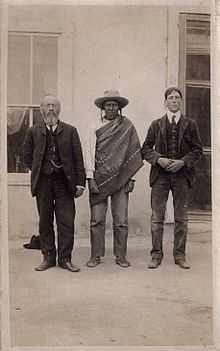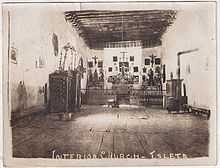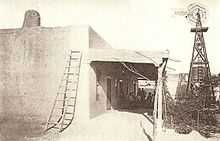Anton Docher









Anton Docher (1852-1928) was a French Franciscan[1] Roman Catholic priest, missionary and defender of the Indians. He was born in 1852 in Le Crest, a small wine growing village of Puy de Dôme in Auvergne. He lived in the pueblo of Isleta in the state of New Mexico for 34 years. His French name was Antonin Jean Baptiste Docher (pronounced ɑ̃tɔnɛ̃ ʒɑ̃ batist dɔʃe ), but his American first name became Anton, and in the American literature he was sometimes called Antonin, Antonio, Anthony, Antoine, Antonine or Antonino.
Biography
During his youth, Father Docher worked in the vineyards with his three brothers and his widowed mother.[2] At the age of 18, he became a student at the "Petit" Seminary of Saint Sauveur in Puy de Dôme, staying there for eight years. At the age of 27, during his first year studying Philosophy in the "Grand" Seminary of Clermont-Ferrand, he was conscripted for military service and was sent to Africa[2][3] then to Cochinchina[4] where he fought for five years in the colonial army, achieving the rank of sergeant. Docher was wounded and decorated for bravery, but his experiences led him to recognise the immorality of colonialism, which he later compared to the fate suffered by Native Americans.[4] Having contracted lung disease whilst in Africa he returned to the "Petit" Seminary as a Prefect.
On October 21, 1887, he went to New Mexico where, after two years of additional studies, he was ordained as a priest in the Cathedral of Santa Fe by J.B.Salpointe.[5] He then served two more years in Bernalillo[2] and in Taos,[6] before arriving in Isleta on December 28, 1891. The Indian village of Isleta is situated on the left bank of the Rio Grande, south of Albuquerque, being populated by Tiwa Indians of the Pueblo people. During his period in Isleta he also served as a priest in Laguna, Acoma,[7] Los Lunas, and Peralta.[8]
In Los Lentes, in 1893, he acquired a massive ancient bell for the chapel which he put in a prominent central belfry.[9]
"The Padre of Isleta" spent 34 years with the Indians. He was a very close friend of Adolph Bandelier,[10][11] Charles Fletcher Lummis[12][13][14] and Pablo Abeita.[15] Like his friend Bandelier he collected Indian objects during this period (kachinas, pottery, basketry and weapons),[16] some of which have been preserved by the Docher and Morvan families. Respected by the Natives Americans for his open-minded attitude to their customs and ancestral faiths (quite normal with friends such as Lummis and Bandelier),[17][18] he was called "Tashide" which means "little helper" in Tewa language.[19] He was also well known to have owned a parrot named Tina which used very foul language,[20][21][22] and a beautiful and luxuriant garden.[23]
During his long stay to Isleta, he met celebrities of this time like the royal family of Belgium, Willa Cather and George Wharton James among others.
Father Docher raised an Isletan orphan boy named Tomas Chavez and when as a man Tomas took a wife, named Lolita Delores, Father Docher gave the couple five acres and a house in Los Lunas as a wedding gift. Tomas developed a vineyard on this land and supplied wine to the Isleta and local churches. Tomas died in 1925, three years before the Father himself. Lolita Delores was left with nine children, and Father Docher paid for two girls, Stella and Margaret, to attend the Sisters of Loretto Orphanage.
Very proud to have been granted American citizenship, Docher described himself as an "Indian" in the letters which he sent to his family.
In September 1912, he presided over the funeral mass of Solomon Luna, powerful businessman and politician of New Mexico, found mysteriously dead in his ranch on August 30, 1912. The mass took place at the Immaculate Conception church of Albuquerque because the parish church Los Lunas was far too small to accommodate the large crowd in attendance.[24]
On October 26, 1919, he was decorated with the Belgium Order of Leopold by King Albert I, who visited the village of Isleta with his Queen Elisabeth and Prince Leopold.[25] In return Father Docher presented the King with a beautiful turquoise cross mounted in silver, and a silver sword made by the Indians.[26] 10 000 persons journeyed to Isleta for the occasion.
In 1923, Father Anton Docher undertook a major remodeling of the San Agustín de la Isleta Mission (previously named San Antonio de Isleta),[27] constructing prominent spires on the adobe walls.[28] He also constructed a sloping roof in order to avoid the water leaks which destroyed the altar constantly.[29][30] The mission has now been restored to a more "traditional" frame.
Father Docher spent the last three years of his life as a patient at the St Joseph Hospital (Albuquerque) and died at the age of 76 on December 18, 1928. Albert Daeger, archbishop of Santa Fe, presided the mass of funeral in the church of Isleta(see photo below). Father Docher is now buried by the side of Father Juan de Padilla in Isleta.[31]
Literature
His adventurous life was told in a novel of Samuel Gance, Anton ou la trajectoire d'un père. The book depicts its childhood in Auvergne, its military period in Tunisia and in Indochina, its departure for New Mexico, its meetings with Charles Lummis, Adolph Bandelier, Pablo Abeita, Willa Cather and the king of the Belgians. The narrative lingers especially over its paternal relation with Tomas Chavez, a young orphan Indian.
A part of his biography was the subject of a book, The Padre of Isleta by Julia Keleher and Elsie Ruth Chant, first published in 1940 and then in 2009 (Sunstone Press).
In Willa Cather's novel Death Comes for the Archbishop, he served as a model for the character of Padre Jesus de Baca.[32] Willa Cather met Father Anton Docher during a visit in Isleta while he was suffering from cataract and near the end of his life.[33] She noted that he lived very poorly and was beloved and respected by "his" Indians, she noted that emanated from his person a great kindness and great humanity. In the novel, the Father de Baca is described "simple like a child and superstitious", while the Padre Docher was often described as droll, intelligent and cultivated.[34][35]
Father Docher wrote an interesting ethnological article published in The Santa Fé Magazine on June,1913, in which he describes the early 20th century's life in the Pueblos,[36] and notably the special Administration of the Pueblo, fully recognized by the United States Government, with a Cacique appointed for life, a Governor (judge in civil cases) elected yearly by the people with two assistants and a War Captain and other officials who have charge of the various celebrations and dances.
History and legends
The life of Docher was also tightly bound to the legends of Isleta, in particular the legend of Padre Juan de Padilla the body of which was considered for getting up of its grave and for roaming in the village some evenings.[4] One day (April 25, 1895), Antonin Docher decided, to investigate this ghost's appearance in the presence of other witnesses and opened the grave of Padre Padilla.[37][38] During this operation Anton Docher injured his arm and the gangrene settled down so much that the doctors recommended amputation. The natives inhabitants evoked the malediction of Padre Padilla. Antonin Docher made a prayer to Padre Padilla to cure him, and the wound disappeared.[39][40][41][42][43]
Notes
- ↑ 20minutos
- ↑ 2.0 2.1 2.2 The Indian Sentinel.1913,p.41-43
- ↑ The Guardian, Little Rock, Arkansas, 12 Jan 1929. P. 1-4
- ↑ 4.0 4.1 4.2 Keleher and Chant. The Padre of Isleta. Sunstone Press, 2009, p. 24-26.
- ↑ The Indian Sentinel, Volumes 7-10. Bureau of Catholic Indian Missions, 1927
- ↑ Leo Crane. Desert Drums: The Pueblo Indians of New Mexico, 1540-1928. Rio Grande Press, 1972.
- ↑ Willa Cather. Death Comes for the Archbishop. Alfred Knopf, 1927, p. 110.
- ↑ Keleher and Chant. The Padre of Isleta. Sunstone Press, 2009, p. 30-77.
- ↑ Jaramillo.A Small History and Folklore – El Pueblo de San Antonio de Los Lentes New Mexico. Los Lunas, San Clemente Parish, 1990.
- ↑ Keleher and Chant. The Padre of Isleta. Sunstone Press, 2009, p. 41.
- ↑ The Southwestern Journals of Adolph F. Bandelier: 1889-1892, edited and annotated by Charles H. Lange, Carroll L. Riley, and Elizabeth M. Lange
- ↑ Lummis in "The Indian Advocate",1 August 1905,p.241
- ↑ Keleher and Chant. The Padre of Isleta. Sunstone Press, 2009, p.88 .
- ↑ Lawrence Clark Powell. Southwest Classics: The Creative Literature of the Arid Lands: Essays on the Books and their Writers. W. Ritchie Press, 1974 , p.47
- ↑ Keleher and Chant. The Padre of Isleta. Sunstone Press, 2009, p.88-93.
- ↑ Willa Cather. Death comes for the Archbishop. Alfred Knopf, 1927, p.109.
- ↑ Keleher and Chant. The Padre of Isleta. Sunstone Press, 2009, p. 46-49.
- ↑ Tisa Joy Wenger. We Have a Religion: The 1920s Pueblo Indian Dance Controversy and American Religious Freedom, p.52
- ↑ Keleher and Chant. The Padre of Isleta. Sunstone Press, 2009, p.37.
- ↑ Samuel Gance. Anton ou la trajectoire d'un père. L'Harmattan, 2013, p.165/190.
- ↑ Keleher and Chant. The Padre of Isleta. Sunstone Press, 2009, p. 83-87.
- ↑ Willa Cather, John Joseph Murphy, David Stouck, Frederick M. Link. Shadows on the Rock
- ↑ Emma Franklin Estabrook.Ancient lovers of peace.1959, p. 57-58.
- ↑ Richard Meltzer. King Solomons Mysterious Demise. New Mexico State Record Center and Archives, 2004-2011
- ↑ Keleher and Chant. The Padre of Isleta. Sunstone Press, 2009, p. 94.
- ↑ W.A.Keleher.The Indian sentinel.1920,vol.2. p.24
- ↑ Frank D. Reeve,History of New Mexico, Volume 1.Lewis Historical Publishing Co.1961 , p.152-153.
- ↑ Christopher Vecsey. On the Padres' Trail. University of Notre Dame Press, 1996 , p.182.
- ↑ The Guardian, Little Rock, Arkansas, 12 Jan 1929. P. 1-4
- ↑ Guggino, Patty. "Los Lentes". New Mexico State Record Center and Archives.
- ↑ Keleher and Chant. The Padre of Isleta. Sunstone Press, 2009, p.108-109.
- ↑ New Mexico magazine, Volume 33, 1955, p.41
- ↑ Willa Cather. Death comes for the Archbishop. Alfred Knopf, 1927, p.425.note 88-89
- ↑ Overland monthly and the Out West magazine, 1908, p.518.
- ↑ James, George Wharton,A little journey to some strange places and peoples in our southwestern land (New Mexico and Arizona), 1911, p. 68.
- ↑ Anton Docher. The Quaint Indian Pueblo of Isleta.The Santa Fé Magazine,1913,vol.7,n°7,p.29-32.
- ↑ Joe L. Montoya. Isleta Pueblo and the Church of St. Augustine, 1978, .p.35-36
- ↑ Keleher and Chant. The Padre of Isleta. Sunstone Press, 2009, p. 50-53.
- ↑ Alice Bullock. Living Legends of the Santa Fe Country, 1985, p.84-85
- ↑ Samuel Carson. The Overland Monthly, Vol. 51, 1908, p.518-520
- ↑ Westways, Vol. 74, 1982, p.46-48
- ↑ Keleher and Chant. The Padre of Isleta. Sunstone Press, 2009, p. 109.
- ↑ Ray John de Aragón. Hidden History of Spanish New Mexico, 2012, p.81
Bibliography
- Novels and biographies
- Samuel Gance, Anton ou la trajectoire d'un père, L'histoire romancée du père Anton Docher. L'Harmattan, Paris, 2013, 208 p. ISBN 978-2336290164
- Keleher, Julia M.; Chant, Elsie Ruth (2009). The Padre of Isleta: The Story of Father Anton Docher. Sunstone press Publishing. ISBN 978-0-86534-714-4.
- References
- Bleiler, Lyn; Strong, Charles (2012). Santa Fe Art and Architecture. Arcadia Publishing. ISBN 978-0-7385-9598-6.
- Boylan, Leona Davis (1974). Spanish colonial silver. Museum of New Mexico Press. ISBN 978-0-89013-066-7.
- Bullock, Alice (1985). Living legends of the Santa Fe country. Sunstone Press. ISBN 0-913270-06-7.
- Cather, Willa (1927). Death comes for the archbishop. Alfred A. Knopf. ISBN 978-1-4179-0423-5.
- Crane, Leo (2007). Desert Drums - The Pueblo Indians of New Mexico 1540-1928. Crane Press. ISBN 1-4067-6246-6.
- De Aragon, Ray John (2006). Padre Martínez and Bishop Lamy. Sunstone Press. ISBN 978-1-60949-760-6.
- De Aragon, Ray John (2012). Hidden History of Spanish New Mexico. The History Press. ISBN 978-0-86534-506-5.
- de Benavides, Alonso; Frederick Webb Hodge; Charles Fletcher Lummis (1965). The memorial of Fray Alonso de Benavides, 1630. Horn and Wallace.
- De Huff, Elizabeth Willis (1945). Say the bells of old missions: legends of old New Mexico churches. B. Herder book co.
- Dendinger, Julia M. (23 April 2011). "Fr. Docher of Isleta pueblo". The News-Bulletin.
- Docher, Anton (1913). "The Quaint Indian Pueblo of Isleta". Santa Fe Magazine 7 (7): 29–32.
- Guggino, Patty. "Los Lentes". New Mexico State Record Center and Archives.
- Hollenback, Amelia; Straw Cook, Mary Jean. Immortal summer. Museum of New Mexico Press, 2002.
- The Indian Sentinel.(1913)-(vol.1-1918)-(vol.2-1920)-(vol.9-1928-29).
- The Guardian, Little Rock, Arkansas, 12 Jan 1929. P. 1-4.
- James, George Wharton (1911). A little journey to some strange places and peoples in our southwestern land. A. Flanagan company. ISBN 978-1-146-26809-7.
- Kessell, John L. (1980). The missions of New Mexico since 1776. University of New Mexico Press. ISBN 978-0-8263-0514-5.
- Lange, Charles H.; Riley, Carroll L.; Lange, Elizabeth M. (1966). The Southwestern Journals of Adolph F. Bandelier: 1889-1892. University of New Mexico Press. ISBN 0-8263-0734-5.
- Major, Mabel; Thomas M. Pearce (1972). Southwest heritage. Univ. of New Mexico Press. ISBN 978-0-8263-0223-6.
- March, John; Marilyn Arnold; Debra Lynn Thornton (1993). A Reader's Companion to the Fiction of Willa Cather. Greenwood Press. ISBN 978-0-313-28767-1.
- Markovich, Nicholas C.; Wolfgang F. E. Preiser; Fred Gillette Sturm (1990). Pueblo style and regional architecture. Van Nostrand Reinhold. ISBN 978-0-442-31896-3.
- Melzer, R. (2008). "Journalist finds danger, love in Isleta". The News-Bulletin.
- Montoya, Joe L. (1978). Isleta Pueblo and the Church of St. Augustine. St. Augustine Parish.
- "New Mexico Historical Review" 32. University of New Mexico. pp. 2–26.
- Paulist Fathers (1943). Catholic world.vol. 157. Paulist Fathers.
- Powell, Lawrence Clark (1974). Southwest classics: the creative literature of the arid lands: essays on the books and their writers. W. Ritchie Press. ISBN 978-0-8165-0795-5.
- Salpointe, Jean Baptiste (1898). Soldiers of the cross: Notes on the ecclesiastical history of New Mexico, Arizona, and Colorado. St. Boniface's Industrial School.
- Secord, Paul R. (2012). Albuquerque Deco and Pueblo. Arcadia Publishing. ISBN 978-0-7385-9526-9.
- Sheehan, Michael Jarboe (1998). Four hundred years of faith: seeds of struggle, harvest of faith : a history of the Catholic Church in New Mexico. Archdiocese of Santa Fe.
- Steele, Thomas J.; Paul Fisher Rhetts, Barbe Awalt (1993). Seeds of struggle/harvest of faith: the papers of the Archdiocese of Santa Fe Catholic Cuarto Centennial Conference : the history of the Catholic Church in New Mexico. LPD Press. ISBN 978-1-890689-00-1.
- Treib, Marc (1993). Sanctuaries of Spanish New Mexico. Berkeley: University of California Press. ISBN 978-0-520-06420-1.
- Taylor, John; Richard Melzer (2011). Catholics Along the Rio Grande. Arcadia publishing. ISBN 978-0-7385-7975-7.
- Twitchell, Ralph Emerson (1912). The leading facts of New Mexican history, Volume 2. Torch Press.
- United States Catholic Historical Society, U.S. Catholic historian, Volume 16. 1998.
- University of New Mexico (1934). The New Mexico quarterly, Numéro 4. University of New Mexico.
- Vecsey, Christopher. On the Padre's trail. University of Notre Dame Press, 1996.ISBN 0268037027.
- Vecsey, Christopher. Pueblo Indian Catholicism: The Isleta Case.U.S. Catholic Historian. Vol. 16, No. 2, Native-American Catholics (Spring, 1998), pp. 1–19. Published by: Catholic University of America Press.
- Wenger, Tisa Joy (2009). We have a religion: the 1920s Pueblo Indian dance controversy and American religious freedom. University of North Carolina Press. ISBN 978-0-8078-3262-2.
- Eleuterio Baca, Benjamin Maurice Read, (1912). Illustrated history of New Mexico. New Mexican Print.